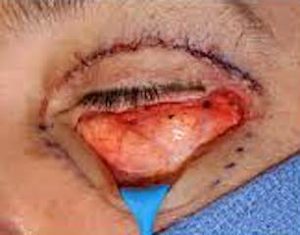
The surgical correction of the tear trough deformity has included orbital fat transposition, release of the orbitomalar ligament and tear trough implants….or some combination of them. While these can be done using an external skin or an internal conjunctival approach, the most consistently effective is the external approach or the skin-muscle flap technique. Its enhanced visibility allows for the redistribution/rearrangement of local tissues to a reproducible autologous rejuvenation effect.
In the June 2017 issue of the journal Plastic and Reconstructive Surgery, an article was published entitled ‘Micro Free Orbital Fat Grafts to the Tear Trough Deformity during Lower Blepharoplasty’. In this paper the authors report their results of 32 lower blepharoplasty patients who had their tear trough deformities treated by the addition of micro free fat grafts with an average followup of one year. In their technique they minced any removed orbital fat pockets into small 2mm to 3mm grafts. (micro free fat grafts) These are then placed into a space created by the release of the orbitomalar ligament. Their results showed consistent good improvement of the tear trough deformity. No patients developed infection or lid deformities. One reoperation due to sclera show was needed (3%) while temporary conjunctival swelling occurred in just over 10%.
Traditional lower blepharoplasty techniques in the face of tear trough can often leave them looking worse by exacerbating the appearance of the preoperative hollows or dark circles. The concept of not merely discarding herniated orbital and reusing it either through pedicled flap transposition or free fat grafts is a logical one. What is appealing about free fat grafts is that they are more versatile than a peddled flap. They can be placed more consistently, in greater volumes and with more precise placement. Such solid small fat grafts have been known to survive for as long as thirty years ago with reports of the use of ‘pearl fat grafts’ in the face.
Free fat grafting of the tear trough during lower blepharoplasty can be done with fat harvested from anywhere not just the use of orbital fat. Small grafts taken from the buccal fat pad is a good example of a regional fat donor source. Whether its survival is as good as orbital fat can not be determined but there is no reason go think that it would be less.
Dr. Barry Eppley
Indianapolis, Indiana


